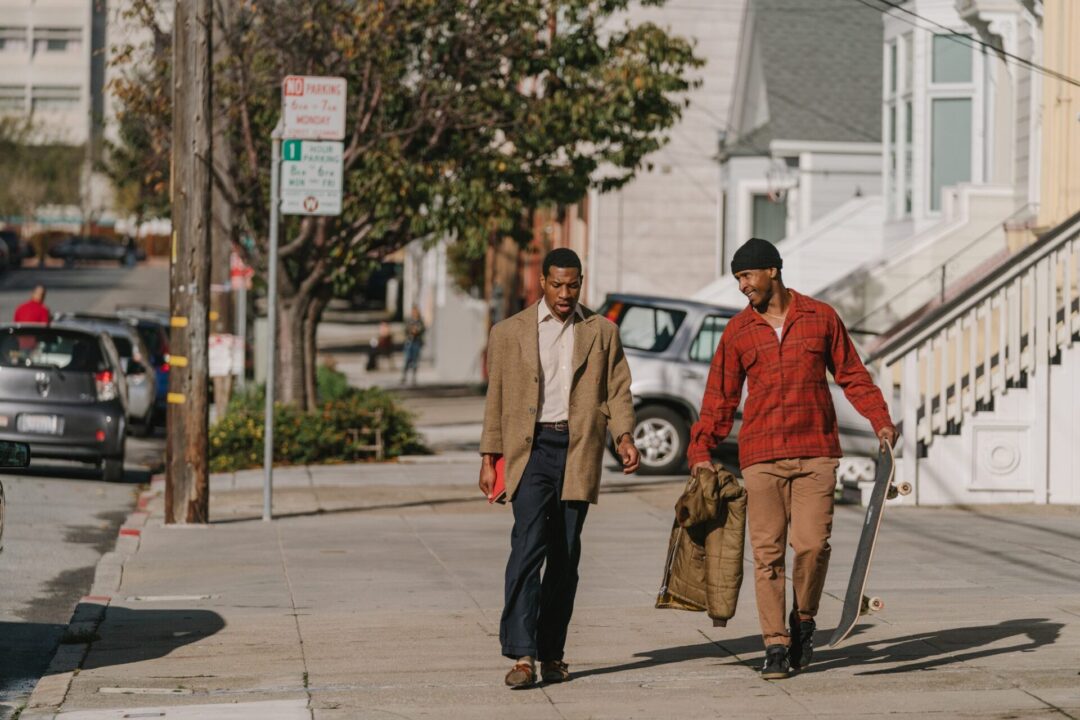Jimmie Fails (Jimmie Fails) likes to show up unannounced at his childhood home. Usually, he has a can of paint in tow, but this could easily be changed out for gardening equipment or cleaning supplies. Whatever he carries, it’s all in service of realizing the image in his head. In his mind’s eye, there exists a glowing picture of the craftsmanship and colors of this house, which, legend has it, his grandfather designed and built as one of the first black men to prosper in San Francisco. And Jimmie won’t let that history be chipped or faded. So even though his family sold the house decades ago, he keeps coming back to faithfully recreate it as it was, new owners wishes be damned.
The white couple that currently owns the swanky Victorian house would describe Jimmie’s visits as incessant. But Jimmie considers them a passion, a service, and a way to stay close to the house he hopes to someday buy back. You see Jimmy was happy there, for a time, and The Last Black Man in San Francisco suggests that the financial dissolution that led to selling the house was a precursor to a more general dissolution, as Jimmie’s family dispersed and their bonds weakened. So, Jimmie skateboards over with his friend Montgomery (Jonathan Majors) anytime he can- often getting found out by the white couple as he weeds their garden or spruces up their trim. It’s a brisk, even funny introduction to a story whose interests naturally encompass gentrification, environmental racism, the physical and psychological constrictions that come with being a black man, and the crisis of values and, ultimately identity, that San Francisco is currently embroiled in.
This balance between character-driven drama and grand mediations makes The Last Black Man in San Francisco an absolute dream of a film. And I mean that in both senses of the word. It’s a dream in the sense that it seems like the platonic ideal of an independent film. It’s passionate, personal, and perceptive. Director Joe Talbot and star and co-writer Jimmie Fails are lifelong best friends actually adapting the true story of Jimmie’s lost family home. Fails plays himself.
And while autobiographical content doesn’t always a great film make, Jimmie’s odyssey, his quest to get home, feels so mythic and resonant when summarized that it’s hard to imagine the film that steams from that not being worthwhile. And of course, the filmmaker’s aren’t married to autobiographical reality. They use their lives and observations as a leaping off point for their narrative creation.
Which brings me to the second way this film is like a dream. Last Black Man in San Francisco has a loose, exploratory structure. The central story of Jimmie and the house creates clear, conventional goals and momentum, but the film embraces anecdotal detours into other San Francisco residents from nudists and trolley pub bros, to tech workers and street performers. Also prominently featured are the group of young black men who frequent Jimmie and Montgomery’s block, their fights and friendships often serving as inspiration for Jimmie’s best friend Montgomery, an aspiring playwright and director played with warm intensity by Jonathan Majors.
The interstitial scenes where Jimmy and Montgomery skateboard across town together (on one board) are so achingly beautiful and enveloping that you find yourself leaning forward as though catching your balance with them. Some might say these poetic moments, which give themselves over entirely to the magnificent soundtrack and landscapes, begin to overtake the film’s cohesion. While I agree that dreamy detours and unexpected plot points are common in this film, I felt carried along by the vision and eager to untangle each choice.
At Sundance, many echoed the sentiment that The Last Black Man in San Francisco is hard to fully appreciate on first viewing because it combines so many ideas and genres. It’s a buddy comedy, character study, tragedy, social commentary, and tone poem whose visuals are so splendid and real-world relevancy so immediate that it demands the deeper engagement that comes with re-watching, discussion, and contemplation. The tapestry of city life and black masculinity weaved onscreen here is certainly dense, but that dense and branching narrative only makes me more excited to watch the film over and over again. And more importantly, for the world to watch along. Because like the film itself, the discussion of it should be a stirring symphony of voices.
The Last Black Man in San Francisco had its world premiere at the 2019 Sundance Film Festival where it won the U.S Dramatic Directing Award and a Special Jury Award for Creator Collaboration.
THE LAST BLACK MAN IN SAN FRANCISCO (2019)
Starring Jimmie Fails, Jonathan Majors, Danny Glover
Directed by Joe Talbot
Story by Joe Talbot, Jimmie Fails
Distributed by A24. 120 minutes. Now playing at ArcLight Hollywood and The Landmark.
Kailee Andrews
Kailee holds a Communication Arts B.A. from the University of Wisconsin. At 21, she programmed her first film festival for an audience of 4,000+ on campus. Since then, it's been all about sharing the cool arts and crafts of cinema.



